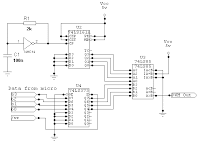PWM Generator with Current Limit Circuit
PWM using 555

IC1 astable gives a fixed square wave at pin 3, C1 and R1 derive
uS trigger pulses from IC1 and this will trigger IC2 monostable or
single shot, the voltage at pin 5 of IC2 will change the pulse width
output of IC2, to get it working all the three RC combinations
have to be figured out
A Simple PWM Circuit Based on the 555 Timer
uS trigger pulses from IC1 and this will trigger IC2 monostable or
single shot, the voltage at pin 5 of IC2 will change the pulse width
output of IC2, to get it working all the three RC combinations
have to be figured out
A Simple PWM Circuit Based on the 555 Timer

The 555 timer in the PWM circuit is configured as an astable
oscillator. This means that once power is applied, the 555 will
oscillate without any external trigger. Before the technical
explanation of the circuit, let's look at the 555 timer IC itself.
PWM generator
oscillator. This means that once power is applied, the 555 will
oscillate without any external trigger. Before the technical
explanation of the circuit, let's look at the 555 timer IC itself.
PWM generator

Here is an assembly very simple to get an oscillator giving
a fixed frequency signal but variable duty cycle. It can - after
amplifier transistor - serve to control the rotation speed of a motor
with direct current or to adjust the power of a dew-heater. We use
once again a logic gate of a CD4093 circuit.
Opamp PWM Generator Circuit

a fixed frequency signal but variable duty cycle. It can - after
amplifier transistor - serve to control the rotation speed of a motor
with direct current or to adjust the power of a dew-heater. We use
once again a logic gate of a CD4093 circuit.
Opamp PWM Generator Circuit
This uses the LM324, a 14-pin DIL IC containing four individual
op-amps and running off a single-rail power supply.
The sawtooth is generated with two of them (U1A and U1B),
configured as a Schmitt Trigger and Miller Integrator, and
a third (U1C) is used as a comparator to compare the sawtooth
with the reference voltage and switch the power transistor.
PWM Generator Circuit by Digital register method
op-amps and running off a single-rail power supply.
The sawtooth is generated with two of them (U1A and U1B),
configured as a Schmitt Trigger and Miller Integrator, and
a third (U1C) is used as a comparator to compare the sawtooth
with the reference voltage and switch the power transistor.
PWM Generator Circuit by Digital register method

an example circuit using the digital comparison method
when a microcontroller is available to set the 4-bit digital register
value. A write strobe is required from the micro to latch the 4 data
bits into the register. The 74HC161 counter is free-running,
the frequency being set by the 74HC14 oscillator section, where
it is roughly f = 1/(6.3RC). The resulting frequency of the PWM
signal will be 16 times less than this counter clock frequency,
since it requires 16 pulses to complete one "revolution" of the
counter. With R=2k and C=1nF this results in a counter
frequency of approximately 80kHz which will result in a PWM signal
frequency of 5kHz.
0 - 100% PWM generator Circuit
The next circuit I found is actually a concoction of 2 separate
designs that cunningly come together to form a 0 - 100% PWM
generator. The first stage uses a single 555 timer to generate a
constant saw tooth waveform.
when a microcontroller is available to set the 4-bit digital register
value. A write strobe is required from the micro to latch the 4 data
bits into the register. The 74HC161 counter is free-running,
the frequency being set by the 74HC14 oscillator section, where
it is roughly f = 1/(6.3RC). The resulting frequency of the PWM
signal will be 16 times less than this counter clock frequency,
since it requires 16 pulses to complete one "revolution" of the
counter. With R=2k and C=1nF this results in a counter
frequency of approximately 80kHz which will result in a PWM signal
frequency of 5kHz.
0 - 100% PWM generator Circuit
The next circuit I found is actually a concoction of 2 separate
designs that cunningly come together to form a 0 - 100% PWM
generator. The first stage uses a single 555 timer to generate a
constant saw tooth waveform.






